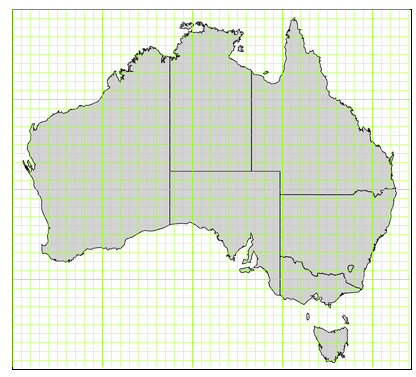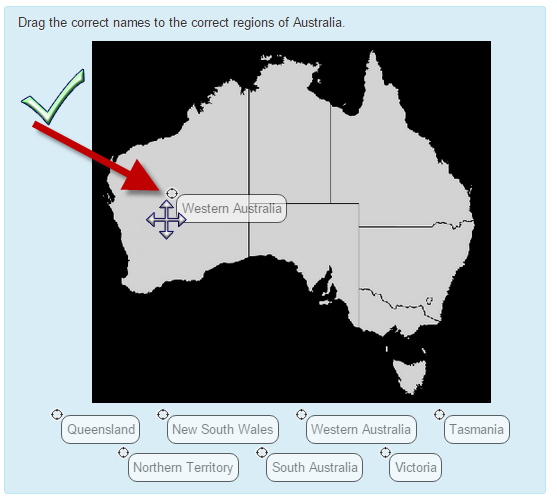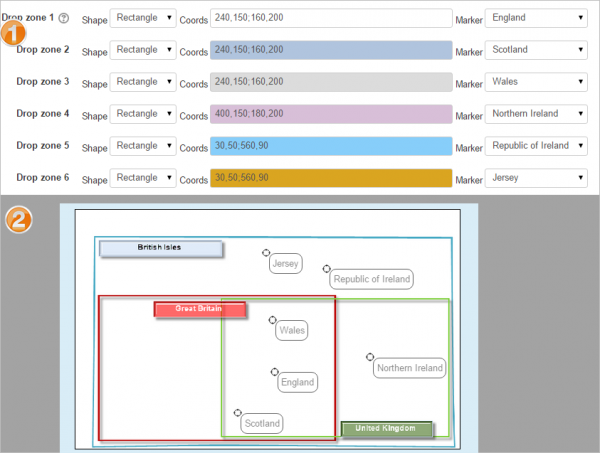- Managing questions
- Question behaviours
- Question types
- Calculated
- Simple Calculated
- Drag and drop into text
- Drag and drop markers
- Drag and drop onto image
- Calculated Multichoice
- Description
- Essay
- Matching
- Embedded Answers (Cloze)
- Multiple Choice
- Random Short Answer Matching
- Select missing words
- Short-Answer
- Numerical
- True/False
- Third-party question types
- Questions FAQ
This question type allows students to drop markers onto an area on a background image. Drag and drop markers questions differ from Drag and drop onto image question type in that there are no predefined areas on the underlying image that are visible to the student.
How to create a question
Give the question a descriptive name to help you find it in the question bank. (Students won't see the name.) In our example, students must correctly locate regions of Australia.
Add the question to the text editor, using any formatting you wish.
In the Preview section, click the background image button to upload an image. Larger images will be displayed at a maximum 600 x 400.Your image will then display under the file upload box. Note that grid lines are visible:
In the Markers section, add the words you want the students to drag onto the areas you select.
In the 'Number' dropdown, you can select the number of times the marker can be used. Selecting 1 means that when it has been used once, it will no longer be available in the list. It is fine to leave the numbers as the default 'Unlimited'; it just means that each marker will still remain once it has been used.
In the Dropzones section, decide the shape you want the selectable areas to be: circle, polygon or rectangle. Our example uses a rectangle. In each 'Marker' dropdown, choose the item you want for that area.
You will now see by your uploaded image that these names are displayed:
Drop zones may be dragged into position and resized using a mouse. Alternatively they can be defined by coordinates. Click the question mark icon next to Drop zone 1 to see how to add coordinates for your chosen shape.
Generally, you should make the drop zones a little bit too big. That is, it is better to occasionally grade an incorrect response right, than to ever grade a correct response as incorrect.
Once all the drop zones have been defined, you can save the changes and preview the question.
Note: When dragging a marker, students must position the little circle top left of the marker in the centre of the area they have selected, not the whole marker, as this might cause confusion and an unexpected incorrect answer.
Using markers and drop zones more than once
If 'Unlimited' is selected from the 'Numbers' dropdown in the Markers section, then the markers may be used more than once.
If the same coordinates must used for several markers in the Drop zones section, then more than one marker may be placed in a single area, as in the example below (1) , where students identify regions of Great Britain, the UK and the British Isles (2):
Scoring and feedback
All drop zones are weighted identically. Only drop zones that are correctly labelled gain marks. There is no negative marking of drop zones that are incorrectly labelled.
If more markers are placed on the image than there are drop-zones a penalty is applied for the extra markers. If there are n drop zones and n+m markers are placed of which p are placed correctly the score is calculated as p/(m+n).
If the question is used in 'interactive with multiple tries' style the marking is modified as follows:
- The mark is reduced for each try by the penalty factor.
- Allowance is made for when a correct choice is first chosen providing it remains chosen in subsequent tries.
Show the number of correct responses: Include in the feedback a statement of how many choices are correct.
State which markers are incorrectly placed: Include in the feedback a list of markers which are incorrectly placed.
Move incorrectly placed markers back to default start position below image: When ‘Try again’ is clicked incorrectly positioned labels are removed.
Accessibility
Marker questions are keyboard accessible. Use the <tab> key to move between the markers and the <arrow> keys to position the markers.
Note: This question type is not accessible to users who are visually impaired.
Changing the dimensions of the images
According to the plugin author, You can easily change the max dimensions of an image in this question type by changing these constants.
See also
- This question type was originally developed by the UK Open University and was a contributed plugin for several years before becoming part of standard Moodle. Find more Open University plugins here.
- Review of this question type
- Video tutorial: How to Create a Question Using the Drag and Drop with Markers Question Type




